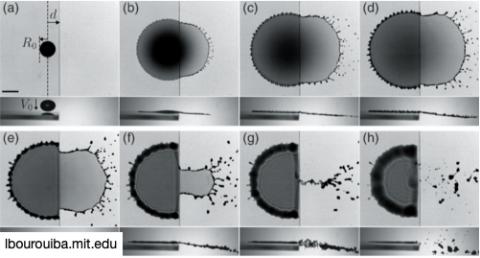Unsteady sheet fragmentation from impact of a drop near a surface edge. The edge fragmentation causes the sheet’s right part to expand in the air, with fragmentation characterized by an unsteady rim bordering the sheet in the air also governed by the unsteady local Bond = 1 in its front part, competing with the speed of contact-line retraction. Ejection of drops on the sides, contact line retraction, and final collapse of the sheet can lead to violent ligament breakup superposed to the primary shedding forward from unsteady fragmentation.
Image: Drop impact on a flat surface close to its edge, from top and side views. The radius of the impacting drop is R0 ≃ 2.4 mm and the Weber number We = 1340. The offset d is defined as the distance between the impact point and the edge. The scale bar is 5mm and the times are (a) t =0, (b) t =1.6, (c) t =3, (d) t =4.4, (e) t =7, (f) t =10.6, (g) t =12.4, and (h) t =19ms after impact.
Context: Asymmetric liquid sheet fragmentation is ubiquitous in nature and potentially shapes critical phenomena such as rain-induced propagation of foliar diseases. We investigate the formation and fragmentation of a liquid sheet upon impact of a drop close to the edge of a solid substrate. Both the impact Weber number and the offset, the distance from the impact point to the edge, are systematically varied. Their influence on the kinematics of the liquid sheet and the subsequent statistics of droplet ejection are rationalized. Three major asymmetry scenarios are identified and linked to distinct droplet ejection patterns. Scaling laws are proposed to rationalize these scenarios based on impact parameters. Selection of droplet emission from various mechanisms are highlighted and the implications on propagation of contaminated fluids from impact discussed.
Source: Lejeune, S., Gilet, T., and Bourouiba, L. (2018) Edge-effect: Liquid sheet and droplets formed by drop impact close to an edge. Physical Review Fluids. 3, 083601. PDF.
In the news and context: MIT NEWS.

